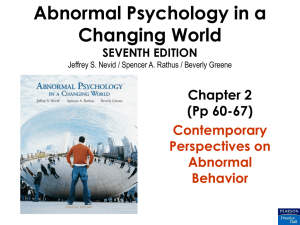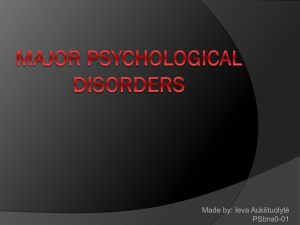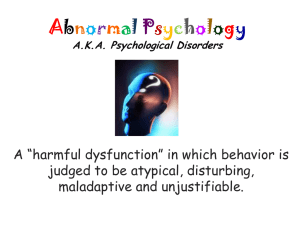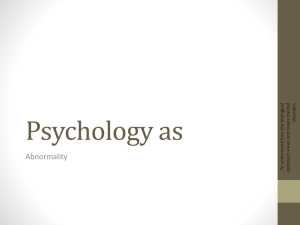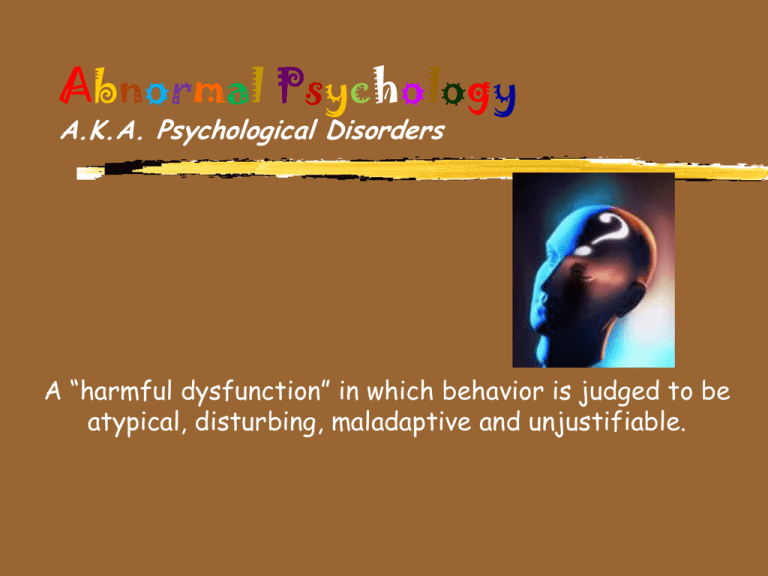
Abnormal Psychology
A.K.A. Psychological Disorders
A “harmful dysfunction” in which behavior is judged to be
atypical, disturbing, maladaptive and unjustifiable.
Hmmmm……
How To Vote via Texting
1. Standard texting rates only (worst case US $0.20)
TIPS 2. We have no access to your phone number
Investigating abnormal
behavior – our first
questions:
• To identify the criteria for judging whether
behavior is psychologically disordered.
• Describe the medical model of psychological
disorders, and discuss the bio-psycho-social
perspective offered by critics of this model.
Activity 1.1
Write down three criteria you believe could
be used to define abnormal behavior
Use the prompt: “Behavior might be
considered psychologically disordered if it is
…”
Brainstorm and reach consensus
Let’s take a look - Scene 1
Denise ignored the reports to buy bottled
water, canned food, plastic sheeting and duct
tape after hearing that there was an
increased threat of terrorism in the Us,
despite the fact that she had time and money
to purchase these.
Scene 2
Steve is passionate in his belief that animals
should not be used in research. He has
devoted his life to the cause. Last week, he
bombed the administrative office of a
pharmaceutical company that is known to
perform animal research. Four people were
injured in the explosion and one died.
Scene 3
Joanna’s mother died suddenly three weeks
ago. She was numb for about a week, but
now is overwhelmed by sadness. She has not
gone back to work yet because she cannot
get herself out of bed in the morning. She
eats very little and feels scared that she will
not be able to cope with future challenges.
Psychological behaviors run a continuum from
very mild to extreme. Everyone has these
behaviors to one degree or another. It is not until a
behavior or feeling interferes with your quality of
life that they become a disorder.
Psychologically disordered behavior involves that
behavior which is atypical, disturbing to
oneself and/or others, maladaptive and not
justifiable to oneself or to others.
Abnormal Behavior: Three Criteria
Behavior that deviates from the norm or that
is atypical.
Hearing voices.
Men who wear women’s clothing for sexual arousal.
Behavior that is maladaptive, disrupting job
or family.
Alcoholism.
Drug addiction.
Behavior that causes personal distress or
pain.
Depression.
Anxiety.
Psychological Disorder
A “harmful dysfunction” in which behavior is
judged to be atypical, disturbing, maladaptive
and unjustifiable.
What is abnormal, disturbing maladaptive
and unjustifiable depends on:
•Culture
•Time Period
•Environmental Conditions
•Individual Person
What is “well-being”
Defining Psychological Well-Being
Carol Ryff – must define well-being in the positive –
following are six core dimensions of well-being:
Self – acceptance: Positive attitude toward the
self but acknowledges and accepts multiple aspects
of the self
Positive relations with other people – capable of
empathy, affection, and intimacy, and are concerned
about the welfare of others
Autonomy – independent, self-determining, and
self-controlled
Environmental mastery – sense of mastery and
competence in managing the environment – able to
choose or create contexts that are supportive of their
personal needs or values
Purpose in life – has both goals and a sense of
directedness – feels that there is meaning to present
and past life and holds beliefs that give life purpose
Personal Growth – see themselves as growing and
expanding – open to new experiences – have a sense
of realizing their potential
Early Theories
Afflicted
people were
possessed by
evil spirits.
Early Theories
Music or singing was
often used to chase
away spirits.
•In some cases
trephening was
used:
Cutting a hole in
the head of the
afflicted to let out
the evil spirit.
Trephening
Early Theories
Another theory was to make the body
extremely uncomfortable.
History of Mental Disorders
In the 1800’s,
disturbed people
were no longer
thought of as
madmen, but as
mentally ill.
They were first put in hospitals.
Did this mean better treatment?
Early Mental Hospitals
They were nothing more than barbaric
prisons.
•The patients were chained
and locked away.
•Some hospitals even charged admission
for the public to see the “crazies”, just like
a zoo.
Philippe Pinel
French doctor who
was the first to take
the chains off and
declare that these
people are sick and
“a cure must be
found!!!”
Somatogenic
At this time- it was believed that mental
illness had a bodily cause- Somatogenic.
But Somatogenic could not explain
disorders such as hysteria (now
called conversion disorder).
Many disorders are psychogenic: the
origin is psychological, not physical.
Current Perspectives
Biological Perspective: psychological
disorders are sicknesses and can be
diagnosed, treated and cured.
Current Perspectives
Bio-Psycho-Social Perspective: assumes
biological, psychological and sociocultural
factors combine to interact causing
psychological disorders.
Used to be called Diathesis-Stress Model:
diathesis meaning predisposition and stress
meaning environment.
Classifying Psychological
Disorders
DSM-IV: Diagnostic
Statistical Manual of
Mental Disorders:
the big book of
disorders.
Two Major Classifications:
Preview
Basic Issues of Mental Disorders
• Sex/culture differences in diagnosis
• Diagnostic issues
Perspectives to study mental
disorders
The idea of multiple causation
Basic Issues of Mental
Disorders
Culturally and Gender specific
Behavior is culturally
dependent
Hissing is a polite way to show respect for superiors in
Japan
Face-to-face conflict is avoided in Thailand – better to
say “Why don’t you go see your house?”
Thailand – polite way to say “no” is to giggle
New Guinea – a man is considered “abnormal” if he
has not engaged in homosexual behavior before
marriage
In societies where hunger is endemic, fat
women are viewed as much more attractive
than slender ones.
India – by leaving some food on the plate, a
guest indicates the generosity of the host
who has so much food out it can’t be finished
Thailand – public displays of affection
between men and women are unacceptable –
interestingly, men holding hands is
considered a sign of friendship.
Latin cultures – children, especially girls, are
socialized to value conformity to social
norms – rebelliousness and delinquency are
rare
Mexican adolescents will be reluctant to
engage in any activity that might bring shame
to their family.
Behavior is gender dependent
Men more likely to hiccup
More boys than girls sleepwalk
A man’s hands are usually warmer –
women’s blood vessels are more
expandable – body can accept 40%
more blood during pregnancy with no
blood pressure increase
A woman’s forehead is more liekly to
feel warm – however, at ovulation her
temp increases about 1 degree and
remains there for 12-14 days prior to
menstuation
Woman’s armpits are smellier
Men perspire most heavily on upper
chest
Women smell, taste, and hear better –
increases as estrogen increases,
peaking at ovulation
Men more likely to wake at night with
a stomach- ache – 2 to 1
Men – more sleep apnea
Men – more sneezing
Who’s heart will still be beating when it’s 78
years old? Women – life expectancy is 79.5 vs
74.1
Perspectives on Mental
Disorders
Sociocultural Perspective
larger culture important to
development of mental disorders
supporting evidence from culturebound syndromes
Anorexia and Bulimia in North America
and Western Europe
Sociocultural: culture-bound
syndromes
Susto
Found mostly in Latin America
Marked by severe anxiety, restlessness,
depression, loss of weight, weakness, rapid heartbeat
and a fear of black magic
Most likely to occur in infants and young children
Claim that it is caused by contact with
supernatural beings or with frightening strangers, or
even by bad air from cemeteries
Treatment involves rubbing certain plants and animals
against the skin
Sociocultural: culture-bound
syndromes
Latah
Occurs among uneducated middle-aged or
elderly women in Malaya
Unusual circumstances (such as hearing
someone say “snake” or even being tickled)
produce a fear response that is characterized
by repeating the words and actions of other
people, uttering obscenities, and acting the
opposite of what other people ask
Sociocultural: culture-bound
syndromes
Koro
Pattern of anxiety found in Southeast Asian men
Involves the intense fear that one’s penis will
withdraw into one’s abdomen, causing death
Caused by an imbalance of ‘yin’ and ‘yang’
Treatment involves keeping a firm hold on his
penis (often with the assistance of family members)
until the fear subsides
Another treatment involves clamping the penis to a
wooden box
Sociocultural: culture-bound
syndromes
Amok
Found in the Philippines, Java, and certain parts of
Africa occurring more often in men than in women
Those suffering the affliction jump around
violently, yell loudly, and attack objects and other
people
Symptoms preceded by social withdrawal and a
loss of contact with reality
The outburst is often followed by depression, then
amnesia
Thought that stress, shortage of sleep, alcohol
consumption, and extreme heat are the primary
causes
Sociocultural: culture-bound
syndromes
Winigo
Intense fear of being turned into a
cannibal by a supernatural monster
Once common among Algonqauin Indian
hunters
Characterized by depression, lack of
appetite, nausea, and sleeplessness
Could be brought on by coming back from
a hunting expedition empty-handed
Some afflicted hunters did kill and eat
,members of their own households
Perspectives
School or Perspective
Cause of Disorder
Psychoanalytic/Psychody
namic
Internal, unconscious conflicts
Behavioral
Reinforcement history/ the environment
Biomedical
Organic problems, biochemical imbalances, genetic predispositions
Cognitive
Irrational, dysfunctional thoughts or ways of thinking
Humanistic
Failure to strive towards one's potential or being out of touch with
one's feelings
Sociocultural
Dysfunctional society
Case Study - Anne
Read your case study
Discuss with a partner
Share with class
Mental Disorders, Basic
Concepts
“Mental Disorder” controversy
Symptom vs. Syndrome
symptom: individual characteristic of thought,
feelings, behaviors
syndrome: constellation of symptoms an individual
shows
Syndrome
clinically significant detriment
internal source of distress
involuntary manifestation
Issues with Diagnosis
reliability: individual diagnosticians
reach the same conclusions using the
same system
DSM-IV: observable characteristics to
maximize reliability
validity: the extent to which the
system’s categories are clinically
meaningful
Labeling people
The Legal Notion of
Insanity:
Insanity is a legal term with three meanings:
(1) Insanity as a criminal defense.
Cannot control behavior or understand its
meaning.
Alternative: Guilty but Mentally Ill.
(2) Insanity as incompetence to stand trial.
Not able to participate in own defense.
(3) Insanity as a condition of involuntary
commitment.
A danger to oneself or others.
Perspectives on Mental
Disorders
Biopsychological Perspective
mental disorders as physical diseases –
focus on symptoms
The perspective has gained credibility
from recent discoveries that genetically
influenced abnormalities in brain structure
and biochemistry contribute to a wide
range of disorders, including
schizophrenia, depression, and anxiety
disorders.
chemical imbalances – impacted by
medicene
birth difficulties
heritability
Perspectives on Mental
Disorders
Psychodynamic Perspective
Sigmund Freud
Unconscious conflicts and drives
over aggressive or sexual impulses
Early childhood trauma
therapy helps person become aware
of underlying conflicts
Currently practiced to a lesser
extent
Perspectives on Mental
Disorders
Cognitive Perspective
conscious thoughts
learned maladaptive thought
patterns cause mental disorder
Behavioral Perspective
learned maladaptive patterns of
behavior cause mental disorder
Multiple Causation
Predisposing causes
High
Amount of stress
in place before onset
make person
susceptible
inherited
characteristics
learned beliefs
sociocultural beliefs
Disorder
manifested
Disorder
not
manifested
Low
Low
High
Predisposition for the disorder
Multiple Causation
Precipitating causes
High
Amount of stress
immediate events
that bring on the
disorder (stress)
loss (e.g., loved
one, job)
perceived threat
when
predisposition high,
precipitating event
may be small
Disorder
manifested
Disorder
not
manifested
Low
Low
High
Predisposition for the disorder
Multiple Causation
Maintaining causes
consequences of the disorder
keep disorder going once it begins
sometimes positive consequences
(e.g., extra attention)
often negative consequences (e.g.,
lack of friends)
Sex Differences in
Prevalence
Large sex differences in prevalence
Differences in Reporting
men report less psychological distress
than women
don’t admit distress?
Physiological vs. psychological distress
tradeoff?
Men use more alcohol and drugs
men seem to express anger more than distress
Issues with Diagnosis
reliability: individual diagnosticians
reach the same conclusions using the
same system
DSM-IV: observable characteristics to
maximize reliability
validity: the extent to which the
system’s categories are clinically
meaningful
Labeling people
DSM IV
A. Published by the American Psychiatric Association,
the DSM-IV, as it is known, is a widely used diagnostic
classification system. It provides a set of criteria which
allows diagnosticians to make assessments.
B. The diagnostic system is based on five axes which
are used by clinicians to provide a complete diagnosis.
1. Axis l includes 16 major categories of adult psychological
disorders, such as mood disorders and schizophrenic
disorders.
2. Axis 2 includes the personality disorders and
developmental disorders.
3. Axis 3 includes medical conditions that might affect or
interact with the client’s psychological disorder, such as
hypothyroidism or headaches.
4. Axis 4 is a rating of recent social and environmental
sources of stress, such as a death in the family or chronic
unemployment.
5. Axis 5 is a Global Assessment of Functioning (GAF)
made on a scale that ranges from 1 to 100, where 100
represents unimpaired function and 1 represents severe
dysfunction
6. An example of how a therapist might make a complete
DSM multiaxial diagnosis is:
a) Axis 1: alcohol dependence
b) Axis 2: dependent personality disorder
c) Axis 3: diabetes
d) Axis 4: death of spouse; unemployment
e) GAF = 60 (moderate symptoms, e.g., occasional panic
attacks or moderate difficulty in social, occupational, or
school functioning)
Criticism of DSM IV
1. The system relies heavily on the medical perspective.
2. Reliability in diagnosis remains a problem;
psychological disorders have "fuzzy borders." Different
disorders share certain characteristics, for example, and
a person might exhibit some, but not all, characteristics
of a particular disorder.
Bias in Diagnosis
Diagnosed as
histrionic
personality
Diagnosed as
antisocial
personality
diagnose men with “male” disorders and women
with “female” disorders
Ford & Widiger (1989)
antisocial = “male” disorder
histrionic = “female” disorder
Differences in Experiences
Men & women have different social
experiences
Women
abuse from spouses
abuse in childhood
traditional roles
As employment for genders becomes
more similar, gender gap in some
disorders decreases
End
Dissociative and
Personality Disorders
Dissociative amnesia (psychogenic)
Lose memory for distant and recent
Lose personal identity – general
knowledge remains intact
No anterograde amnesia
Often reverses itself abruptly
Dissociation
Incapacity to integrate one’s thoughts,
feelings or experiences into one’s present
consciousness
The Curious Experiences Survey – measures self
reported Dissociative experiences.
Total your score
Range from 17 – 85 – higher means more
experience with dissociation
Three factors in dissociation:
Depersonalization
Self-absorption
Amnesia
Dissociative Disorder
Interview Schedule
Have you ever walked in your sleep?
Did you have imaginary playmates as a child?
Were you physically abused as a child or
adolescent?
Were you sexually abused as a child or
adolescent?
Have you ever noticed that things are
missing from your personal possessions or
where you live?
Have you ever noticed that things appear
where you live, but you don’t know where
they cam from or how they got there?
Do people ever talk to you as if they know
you but you don’t know them, or only know
them faintly?
Do you ever speak about yourself as “we” or
“us”?
Do you ever feel that there is another person
or persons inside you?
If there is another person inside you, does he
or she ever come out and take control of your
body?
Personality Disorders
Important: Strictly for research, not clinical
diagnosis.
Score one for every true
Used in a study of risk taking:
8.33 for residents in long-term drug rehap
6.06 for skilled rock climbers
5.15 for Police officers/fire fighters
commended for bravery
Major Depressive Disorder
Reverse responses to 2, 5, 6, 11, 12, 14, 16,
17, 18, and 20.
(1=4, 2=3, 3=2, 4=1)
Add all numbers
Range from 20 – 80
50-59 – suggest mild to moderate depression
60 – 69 indicate moderate to severe
depression
>70 – severe depression
College Especially prone to depression – experience
all the stress transitions simultaneously
Lose family
Lose friends
Lose familiar surroundings
Equally able students
Suicide
Unendurable psychological pain
Frustrated psychological needs
The search for a solution
An attempt to end consciousness
Helplessness and Hopelessness
Constriction of options
Ambivalence
Communication of intent
Departure
Lifelong coping patterns
• It is estimated that depression increases the risk
of a first suicide attempt by at least 14-fold.
• Over half of all kids who suffer from depression
will eventually attempt suicide at least once, and
more that seven percent will die as a result.
• Four times as many men commit suicide than
women, but young women attempt suicide three
times more frequently than young men.
• Fifty-three percent of young people who commit
suicide abuse substances.
• Firearms are used in a little more than half of all
youth suicides.
Close-up Extension: Self
Mutilation
Reverse 2, 3, 5, 7, 9, 11, 13, 17, 22
Add all numbers
Range from 24 – 120
Higher – more positive emotional investment
in one’s body
Higher scale report higher self-esteem as
well as having experienced greater maternal
care – more likely to indicate a capacity to
enjoy sensual and bodily pleasures
Body Image Feelings and Attitudes
# 5, 10, 13, 16, 17, and 21
Comfort in Physical Contact with
Oters
#2, 6, 9, 11, 20, and 23
Concern for Body Care
#1, 4, 8, 12, 14, and 19
Investment in body Protection
#3, 7, 15, 18, 22, and 24
Self Mutilation
2 million self-mutilators – vast majority
women
Typically begin as teenagers
Princess Diana brought attention to the
disorder
Some suicidal, most do it to cope with
stresses
Many sexually abused as children learning to
shield themselves by dissociating
Almost all – grew up with poor
communication between parent and child
Schizophrenia
Schizophrenia
literal translation “split mind”
a group of severe disorders
characterized by:
disorganized and delusional thinking
disturbed perceptions
inappropriate emotions and actions
Schizophrenia
Delusions
false beliefs, often of persecution or
grandeur, that may accompany
psychotic disorders
Hallucinations
sensory experiences without
sensory stimulation
Psychosis refers to a general lack of
contact with reality
Schizophrenia
form of psychosis involving
disorders of
perception
language
thought
emotion
behavior
Schizophrenia Symptoms
Perceptual Symptoms
Sensory filtering & perception impaired
Hallucinations - perceptions without
sensations
Language and Thought Disturbance
Word salad: jumbled speech
Delusions - mistaken beliefs maintained despite
contrary evidence
Paranoid
Persecution
Schizophrenia Symptoms
Emotional Disturbance
Behavioral Disturbance
Unusual actions that have
meaning to the person
Catalepsy immobile stance
(like a statue)
Waxy Flexibility
Refusal to communicate with
others
Classification of Schizophrenia
1.
Positive symptoms involve distorted or excessive
mental activity
Delusions, hallucinations,altered emotions,
erratic behaviors
Positive symptoms occur during acute
episodes
2. Negative symptoms involve behavioral and
mental deficits
Flattened emotions, social withdrawal
Negative symptoms are chronic
3. Disorganization of behavior
Biological Views of Schizophrenia
Genetics: 43 to 83%
concordance (identical
twins)
Neurotransmitters:
Dopamine activity excessive
in the schizophrenic brain
Brain damage: enlarged
ventricles are evident in
schizophrenia
A common finding in
the brains of people
with schizophrenia is
larger than normal
lateral ventricles.
Heritability of Schizophrenia
Biological Views of Schizophrenia
Genetics: 43 to 83%
concordance (identical twins)
Neurotransmitters: Dopamine
activity excessive in the
schizophrenic brain
Brain damage: enlarged
ventricles are evident in
schizophrenia
Decreased frontal and temporal
lobe activity
Other potential causes…
A common finding in
the brains of people
with schizophrenia is
larger than normal
lateral ventricles.
Psychosocial Theories of
Schizophrenia
Stress –
Diathesis-stress model
Genetic predisposition +
overwhelming stress
Family communication
Schizophrenia
Schizophrenia
Understanding Schizophrenia
Triggering experiences, genes predispose but
some react to traumatic triggers by
developing schizophrenia.
Biochemical: 6 times the normal amount of
dopamine receptors that increase brain
activity to manic levels. Thus dopamine
blockers reduce symptoms.
Dopamine-blocking drugs have little impact
on persistent negative symptoms
It is also thought to perhaps be triggered or
caused by the introduction of a prenatal virus
that affects brain development, possibly in
the thalamus. People conceived in Winter
months are more apt to develop
schizophrenia in Northern hemisphere, while
the reverse is true in the Southern.
Abnormal brain activity – low in frontal lobes
Studies have found enlarged, fluid-filled areas
Genetic Factors
Definite genetic link: the closer you are
genetically to someone with Schizophrenia,
the more likely you are to get it.
1 in 100 people get it.
1 in 10 of siblings
1 in 2 identical twins, even if raised apart
Psychological Factors
Genetically predisposed physiological
abnormalities do not, by themselves,
cause schizophrenia, neither do
prenatal and psychological factors
alone
MAYBE, in conjunction, there are
psychologial triggers
As the bio-psycho-social perspective
emphasizes, the traffic runs both
ways.



